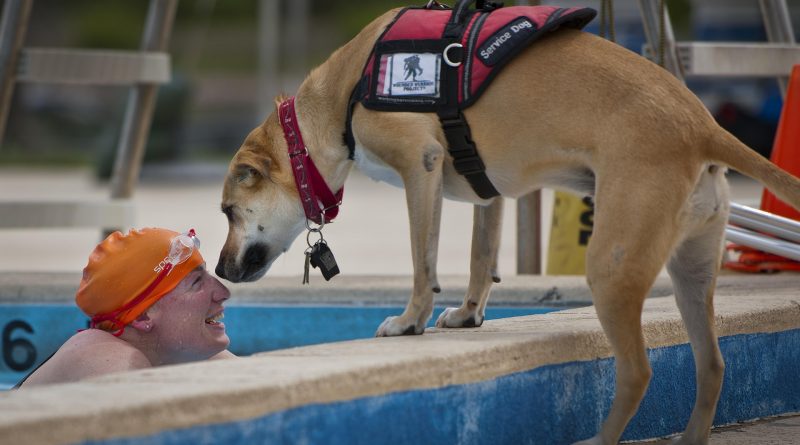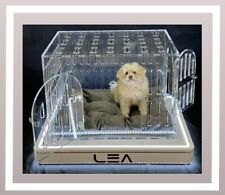Traveling Challenges with Emotional Support Animals

If you rely on an Emotional Support Animal (ESA) or follow the news, you may have noticed recent stories about some unusual species in the airport.
It may leave you wondering about the different kinds of support animals that are out there – and what it may mean for you and others traveling.
Let’s Clear the Air
First, let’s properly classify the three main types of support animals. Bear with me, this is going to get a little bit technical. As a pet owner and traveler, you deserve to know how these animals are classified based on the law and by airline policy. This article is intended for those curious about support animals and air travel within or transiting the United States of America.
- Service Animals
Service animals can also be ESAs BUT their primary job is to assist a disabled person in a task or tasks. Many of us think of a service animals as a “seeing-eye dog” or a dog assisting a person with hearing impairment.
Nowadays, there are animals that help people with a great number of medical problems or disabilities. For instance, dogs are trained to notify diabetics before their blood sugar becomes dangerously low or to alert an epileptic of an oncoming seizure. Some dogs can even detect when migraines are going to occur – helping suffers prevent them and improve their quality of life.
Service animals are not only pets, they are a vital tool for their owner. They are typically ‘unflappable’ and focused on doing their job. It is incredibly rare for a service animal to be unruly or aggressive to passers-by or strangers. They typically do not interact with passers-by, they are focused on their job and owner.
It is vital that persons with medical problems or disabilities be allowed to travel with their service animals. Let’s see what the law has to say about it.
According to the Americans with Disabilities Act (1990):
“Any dog that is individually trained to do work or perform tasks for the benefit of an individual with a disability, including a physical, sensory, psychiatric, intellectual, or other mental disability. Other species of animals, whether wild or domestic, trained or untrained, are not service animals for the purposes of this definition. The work or tasks performed by a service animal must be directly related to the individual’s disability. Examples of work or tasks include, but are not limited to, assisting individuals who are blind or have low vision with navigation and other tasks, alerting individuals who are deaf or hard of hearing to the presence of people or sounds, providing non-violent protection or rescue work, pulling a wheelchair, assisting an individual during a seizure, alerting individuals to the presence of allergens, retrieving items such as medicine or the telephone, providing physical support and assistance with balance and stability to individuals with mobility disabilities, and helping persons with psychiatric and neurological disabilities by preventing or interrupting impulsive or destructive behaviors. The crime deterrent effects of an animal’s presence and the provision of emotional support, well-being, comfort, or companionship do not constitute work or tasks for the purposes of this definition.”
Miniature horses have been added as a specific provision to the ADA. The miniature horse must be housebroken, under the handler’s control, can be accommodated for by the facility, and will not compromise safety regulations.
When it comes to airline travel, airlines allow the following service animals, according to the Air Carrier Access Act (ACAA) and CFR Part 382:
“Any animal is individually trained or able to provide assistance to a qualified person with a disability; or any animal shown by documentation to be necessary for the emotional well-being of a passenger… Psychiatric service animals are recognized as service animals, but are considered to be emotional support animals and, therefore, subject to the applicable regulatory requirements, i.e. documentation.”
- Therapy Animals
Therapy animals are specifically trained to provide animal-assisted intervention in a treatment program or process. These animals are certainly able to travel by air, but are not considered service animals under the law. Therapy animals have to travel like any other pet – in airline approved carry-on luggage or in the cargo compartment of the aircraft.
- Emotional Support Animals
ESAs are invaluable assets to their owners. Many veterans rely on ESAs as they battle PTSD. Others suffering with anxiety disorders, autism or depression can benefit from an ESA. If you couple a disability-related need with travel – that ESA may be the only way that a person can travel in comfort and safety.
The Problem of Fraud

Assistance animals of all types have gotten a bad rap lately because of rampant fraud. Doting puppy parents play the system by buying fake vests and certificate online and pass their pet off as a legitimate assistance animal. In the past, this has been all it took to get a pet into the cabin at zero cost.
Now, the airlines are tightening their requirements.
How does this play into today’s air travel climate? Let’s look at the rules on the books:
“An emotional support animal (ESA) may be an animal of any species, the use of which is supported by a qualified physician, psychiatrist or other mental health professional based upon a disability-related need. An ESA does not have to be trained to perform any particular task. ESAs do not qualify as service animals under the Americans with Disabilities Act (ADA), but they may be permitted as reasonable accommodations for persons with disabilities under the Fair Housing Act.
The Air Carrier Access Act provides specific allowances for ESAs traveling on airlines, though documentation may need to be provided.”
(Fair Housing Act (42 U.S.C. Part 3604) and Air Carrier Access Act (ACAA) and C.F.R. Part 382.117)
What about my Emotional Support Peacock?
This new story is a difficult one. While a person should be able to take their ESA onto an aircraft (see rules stated above), the airline did have a valid concern regarding the peacock. Peacocks are very large and male peacocks can become aggressive when stressed. Being cooped up in an aircraft cabin, or simply being seated next to a rambunctious toddler – could have caused a serious safety issue during flight.
The Air Carrier Access Act is very vague and thus allows the airlines with a lot of ‘wiggle room’ when it comes to their specific ESA policies. Recently, Delta Airlines tightened their ESA policy.
What next?
The assistance animal story is far from finished. As assistance animals (legitimate and fraudulent ones) become more commonplace in air travel, you will find that policies and even laws will be in flux.
If you rely on an ESA or service animal, be sure that you have all the appropriate documentation from your physician or therapist before considering air travel. Contact the airline directly regarding their current policy, as certain species may be prohibited and advance notice may be necessary.
For additional information, please refer to these resources
American Veterinary Medical Association (AVMA) – Assistance Animals, Access and the Problem of Fraud: https://www.avma.org/KB/Resources/Reports/Documents/Assistance-Animals-Rights-Access-Fraud-AVMA.pdf
Service, Emotional Support and Therapy Animals: https://www.avma.org/KB/Resources/Reference/AnimalWelfare/Pages/Service-Emotional-Support-Therapy-Animals.aspx
Can Peacocks Be Support Animals?: https://news.nationalgeographic.com/2018/01/woman-brings-peacock-plane-emotional-support-animal-explained-spd/













